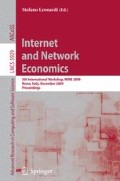Abstract
Fair allocation of goods or resources among various agents is a central task in multiagent systems and other fields. The specific setting where just one divisible resource is to be divided fairly is commonly referred to as cake-cutting, and agents are called players in this setting. Cake-cutting protocols aim at dividing a cake and assigning the resulting portions to several players in a way that each of the players, according to his or her valuation of these portions, feels to have received a “fair” amount of the cake. An important notion of fairness is envy-freeness: No player wishes to switch the portion of the cake received with another player’s portion. Despite intense efforts in the past, it is still an open question whether there is a finite bounded envy-free cake-cutting protocol for an arbitrary number of players, and even for four players. In this paper, we introduce the notion of degree of guaranteed envy-freeness (DGEF, for short) as a measure of how good a cake-cutting protocol can approximate the ideal of envy-freeness while keeping the protocol finite bounded. We propose a new finite bounded proportional protocol for any number n ≥ 3 of players, and show that this protocol has a DGEF of \(1 + \left\lceil{n^2}/{2} \right\rceil\). This is the currently best DGEF among known finite bounded cake-cutting protocols for an arbitrary number of players. We will make the case that improving the DGEF even further is a tough challenge, and determine, for comparison, the DGEF of selected known finite bounded cake-cutting protocols, among which the Last Diminisher protocol turned out to have the best DGEF, namely, 2 + n(n − 1)/2. Thus, the Last Diminisher protocol has \(\left\lceil {n}/{2} \right\rceil - 1\) fewer guaranteed envy-free-relations than our protocol.
Access this chapter
Tax calculation will be finalised at checkout
Purchases are for personal use only
Preview
Unable to display preview. Download preview PDF.
References
Akin, E.: Vilfredo Pareto cuts the cake. Journal of Mathematical Economics 24(1), 23–44 (1995)
Brams, S., Jones, M., Klamler, C.: Divide-and-Conquer: A proportional, minimal-envy cake-cutting procedure. In: Dagstuhl Seminar 07261. Dagstuhl Seminar Proceedings (2007)
Brams, S., Taylor, A.: An envy-free cake division protocol. The American Mathematical Monthly 102(1), 9–18 (1995)
Brams, S., Taylor, A.: Fair Division: From Cake-Cutting to Dispute Resolution. Cambridge University Press, Cambridge (1996)
Brams, S., Taylor, A., Zwicker, W.: A moving-knife solution to the four-person envy-free cake-division problem. Proceedings of the American Mathematical Society 125(2), 547–554 (1997)
Chauduri, A.: Formal properties of interpersonal envy. Theory and Decision 18, 301–312 (1985)
Chauduri, A.: Some implications of an intensity measure of envy. Social Choice and Welfare 3(4), 255–270 (1986)
Even, S., Paz, A.: A note on cake cutting. Discrete Applied Mathematics 7, 285–296 (1984)
Feldman, A., Kirman, A.: Fairness and Envy. The American Economic Review 64(6), 995–1005 (1974)
Feldman, A., Weiman, D.: Envy, wealth, and class hierarchies. Journal of Public Economics 11(1), 81–91 (1979)
Fink, A.: A note on the fair division problem. Mathematics Magazine 37(5), 341–342 (1964)
Kuhn, H.: On games of fair division. In: Shubik, M. (ed.) Essays in Mathematical Economics in Honor of Oskar Morgenstern, Princeton University Press, Princeton (1967)
Lindner, C., Rothe, J.: Degrees of guaranteed envy-freeness in finite bounded cake-cutting protocols. Technical Report cs.GT/0902.0620, ACM Computing Research Repository (CoRR) (September 2009), http://arxiv.org/abs/0902.0620
Magdon-Ismail, M., Busch, C., Krishnamoorthy, M.: Cake-cutting is not a piece of cake. In: Alt, H., Habib, M. (eds.) STACS 2003. LNCS, vol. 2607, pp. 596–607. Springer, Heidelberg (2003)
Procaccia, A.: Thou shalt covet thy neighbor’s cake. In: Proceedings of the 21st International Joint Conference on Artificial Intelligence, IJCAI, July 2009, pp. 239–244 (2009)
Robertson, J., Webb, W.: Near exact and envy free cake division. Ars Combinatoria 45, 97–108 (1997)
Robertson, J., Webb, W.: Cake-Cutting Algorithms: Be Fair If You Can. A K Peters, Stanford (1998)
Steinhaus, H.: The problem of fair division. Econometrica 16, 101–104 (1948)
Steinhaus, H.: Sur la division pragmatique. Econometrica 17, 315–319 (1949)
Steinhaus, H.: Mathematical Snapshots, 3rd edn. Oxford University Press, New York (1969)
Stromquist, W.: How to cut a cake fairly. The American Mathematical Monthly 87(8), 640–644 (1980)
Tasnádi, A.: A new proportional procedure for the n-person cake-cutting problem. Economics Bulletin 4(33), 1–3 (2003)
Woeginger, G., Sgall, J.: On the complexity of cake cutting. Discrete Optimization 4(2), 213–220 (2007)
Author information
Authors and Affiliations
Editor information
Editors and Affiliations
Rights and permissions
Copyright information
© 2009 Springer-Verlag Berlin Heidelberg
About this paper
Cite this paper
Lindner, C., Rothe, J. (2009). Degrees of Guaranteed Envy-Freeness in Finite Bounded Cake-Cutting Protocols. In: Leonardi, S. (eds) Internet and Network Economics. WINE 2009. Lecture Notes in Computer Science, vol 5929. Springer, Berlin, Heidelberg. https://doi.org/10.1007/978-3-642-10841-9_15
Download citation
DOI: https://doi.org/10.1007/978-3-642-10841-9_15
Publisher Name: Springer, Berlin, Heidelberg
Print ISBN: 978-3-642-10840-2
Online ISBN: 978-3-642-10841-9
eBook Packages: Computer ScienceComputer Science (R0)

